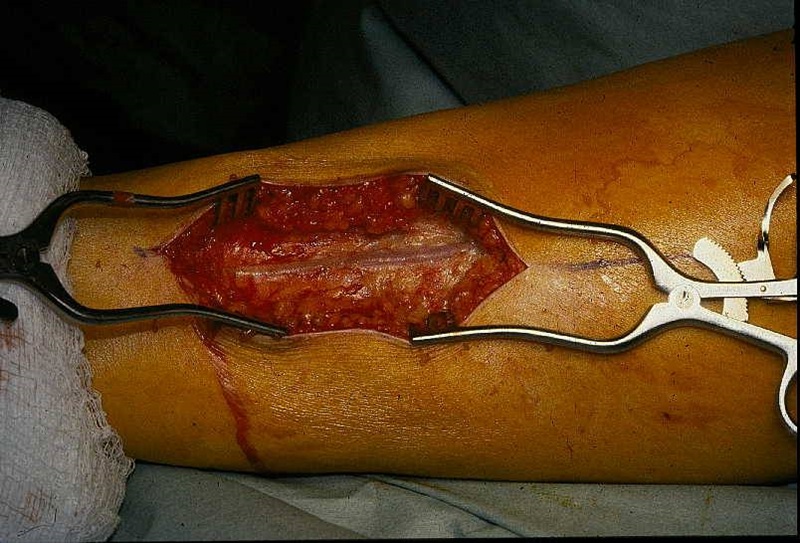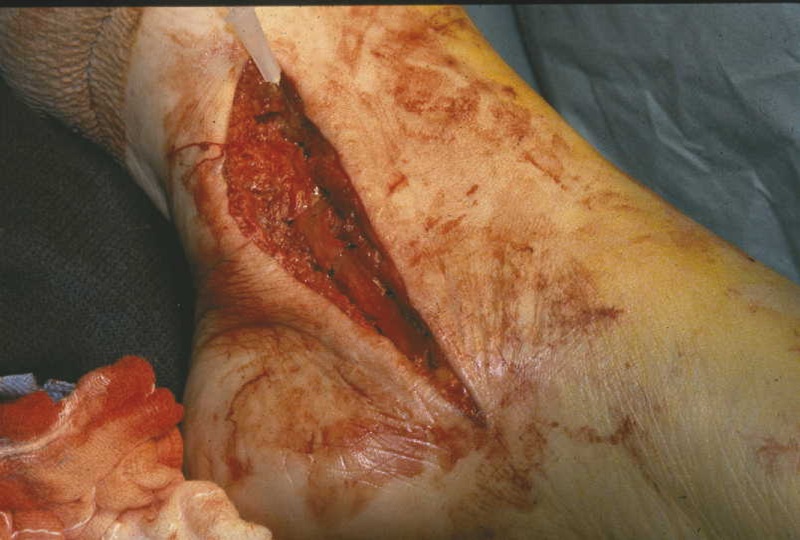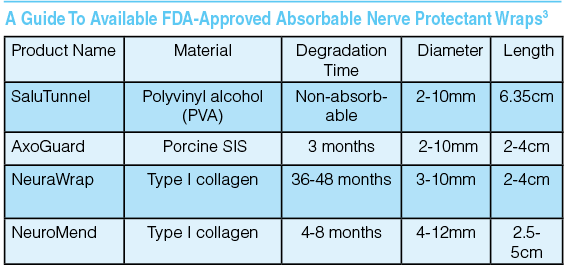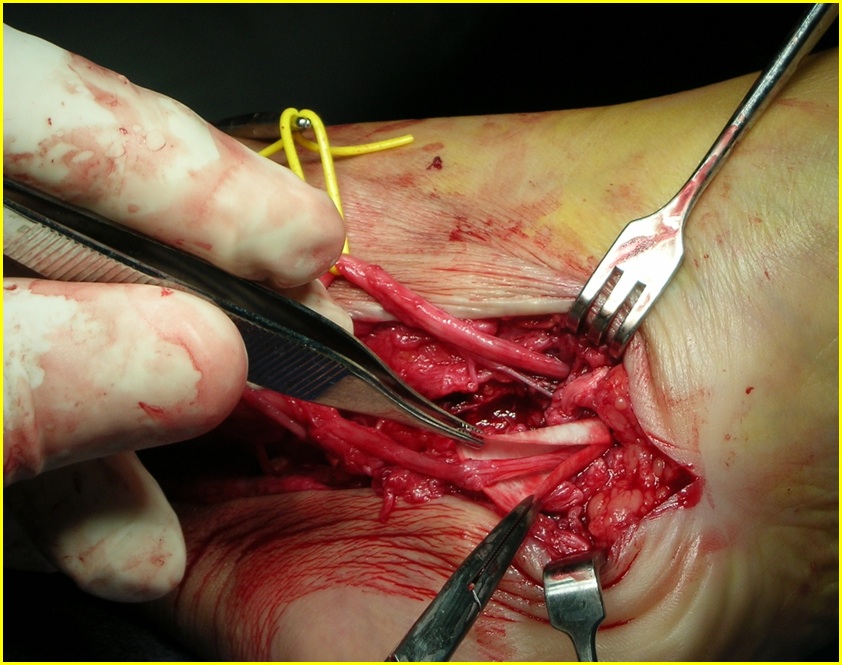ADVERTISEMENT
A Guide To Nerve Wrapping For Tarsal Tunnel Surgery
Adhesive neuritis can be a challenging, unpredictable complication of tarsal tunnel surgery. Accordingly, this author offers a closer look at the emergence of nerve wrapping to prevent post-op extraneural scarring.
 Primary tarsal tunnel decompression surgery for tarsal tunnel syndrome is sometimes unsuccessful in providing satisfactory symptomatic relief. When this occurs and despite the presence of an intact posterior tibial nerve, revisional surgery will often be necessary.
Primary tarsal tunnel decompression surgery for tarsal tunnel syndrome is sometimes unsuccessful in providing satisfactory symptomatic relief. When this occurs and despite the presence of an intact posterior tibial nerve, revisional surgery will often be necessary.
There are many potential causes of recurrent tarsal tunnel syndrome. We can loosely divide these etiologies into six categories: incorrect initial diagnosis; inadequate release; adhesive neuritis; intraneural damage; double crush syndrome and idiopathic causes.1 Adhesive neuritis or tethering of the nerve to scar tissue can be an unpredictable outcome that can occur in even the most experienced surgeon’s hands. This postoperative extraneural scarring can cause ischemia in the nerve, circumferential mechanical constriction and/or impaired gliding of the nerve.2 In recent years, the idea of nerve entubulation or “wrapping” around the nerve has emerged as a means of providing a barrier or “shield” against such extraneural scarring.
The ideal barrier nerve wrap is one that the surgeon can place around a nerve that has undergone external neurolysis and decompression. In addition to limiting postoperative external nerve scarring, this nerve wrap would offer the following properties:
 1) biocompatibility and no provocation of inflammatory response;
1) biocompatibility and no provocation of inflammatory response;
2) flexible, soft and of sufficient size to prevent constriction or compression upon the repaired nerve;
3) biomaterial that is biodegradable while maintaining a stable mechanical architecture during the healing process, including tear resistance if sutures are involved;
4) biomaterial that is semi-permeable to allow the influx of oxygen and nutrients from the interstitial fluid to the repaired nerve tissue through pores in the biomaterial wall;
5) biomaterial that is sufficiently impermeable to prevent the influx of fibrous tissue ingrowth through the biomaterial wall and retain the secreted neurotrophic factors of the repaired nerve;
6) biomaterial that is neuroinductive and neuroconductive; and
7) biomaterial that one can easily obtain, sterilize and store, and that has good surgical handling properties (e.g., ease of placement and suture tear resistance).3
Physicians have used many substances as barrier nerve wraps. These substances include fat, fascia, collagen, gelatin, decalcified bone, blood vessels (veins), cartilage, muscle, polyglactin, rubber, silicone tubing, silicone sheeting and amniotic membrane. Unfortunately, the literature and research on most of these substances have concentrated on their use as nerve conduits for the repair of nerve deficits where one must span a nerve gap to allow nerve regeneration. There is very limited evidence supporting any of these materials as barrier nerve wraps. Although the evidence is limited, several of these substances have shown early promise in the described role of wrapping previously scarred nerves following external neurolysis. At this time, there is no one universally preferred material for nerve wrapping.
 Who Is A Candidate For Nerve Wrapping?
Who Is A Candidate For Nerve Wrapping?
Patients with scar-tethered nerves usually have a history of previous surgery (e.g., prior tarsal tunnel decompression surgery), trauma (e.g., open fracture, dislocation or crush injury) or infection. These patients present most often with unrelenting, severe, neuritic pain that is often elusive in nature. In cases of recurrent tarsal tunnel pain, the symptom complex will frequently include varying combinations of burning and lancinating pain, numbness, paresthesias, dysesthesias and the sympathetic dysfunction commonly associated with tenderness to palpation of the involved nerve(s) and a positive Tinel’s sign with percussion of the involved nerve(s).
Furthermore, the patient’s history frequently reveals that the patient had temporary, short-term relief after the index neurolysis surgery. The symptoms may have subsided for weeks or months until recurrent scar tissue formation tethers the nerve, causing adhesive neuritis and a return of pain. In the case of a recurrent tarsal tunnel syndrome, the physical examination may reveal tenderness over the posterior tibial nerve, porta pedis and/or medial heel and distal tingling upon percussion (i.e., positive Tinel’s sign) with percussion of the posterior tibial nerve and/or its terminal branches.
 Electrodiagnostic testing usually reveals slowing of sensory nerve conduction velocities, and both sensory and motor latencies may be delayed. However, remember that the electrodiagnostic testing is not definitive and when scar tissue inhibits the nerve gliding of an intact nerve with less than moderate nerve compression, the electrodiagnostic studies may be normal. In cases of adhesive neuritis, advanced imaging modalities such as magnetic resonance imaging (MRI) or musculoskeletal ultrasound will likely reveal findings consistent with post-surgical changes and the accompanying scar tissue.
Electrodiagnostic testing usually reveals slowing of sensory nerve conduction velocities, and both sensory and motor latencies may be delayed. However, remember that the electrodiagnostic testing is not definitive and when scar tissue inhibits the nerve gliding of an intact nerve with less than moderate nerve compression, the electrodiagnostic studies may be normal. In cases of adhesive neuritis, advanced imaging modalities such as magnetic resonance imaging (MRI) or musculoskeletal ultrasound will likely reveal findings consistent with post-surgical changes and the accompanying scar tissue.
The primary indication for nerve wrapping is following the neurolysis of scar tissue that both compresses the involved nerve and causes adhesions between the nerve and surrounding tissues. Wrapping the nerve prevents recurrent adhesive scar tissue and pain from traction on the nerve.
Pertinent Insights On The Surgical Technique Of Nerve Decompression And Nerve Wrapping
Any surgical nerve decompression technique that involves nerve wrapping starts with external neurolysis with, or more commonly without, internal neurolysis. Make an incision over the involved nerve(s). If there was a previous incision, use the same incision (if possible), extending it both proximally and distally. The proximal and distal extensions of the prior incision allow the surgeon to identify the involved nerve(s) in normal, unscarred tissue where one can then trace the nerve into the entrapment site.
Carefully dissect the nerve free from the incarcerating scar tissue throughout the length of the wound, preferably under loupe or similar magnification. After full decompression of the nerve, perform gentle, circumferential release of the nerve from all adhesions. Optimally, when only external neurolysis is needed, one can leave the epineurium of the involved nerve(s) intact. In the case of recurrent tarsal tunnel syndrome, the surgeon should address any scarring or damage of adjacent tendons via tenolysis and/or tendon repair.
 After performing a complete external neurolysis, take measurements for the appropriate nerve wrap and then cut it to size, insert the wrap and suture it (if needed). Then close the subcutaneous tissue and skin. It is not recommended to close the laciniate ligament (i.e., flexor retinaculum), and I routinely leave it unsutured.
After performing a complete external neurolysis, take measurements for the appropriate nerve wrap and then cut it to size, insert the wrap and suture it (if needed). Then close the subcutaneous tissue and skin. It is not recommended to close the laciniate ligament (i.e., flexor retinaculum), and I routinely leave it unsutured.
What The Literature Reveals About Nerve Wrapping With Different Biomaterials
My initial experience with nerve wrapping involved the placement of 0.007-inch silicone sheeting around the involved nerves after external neurolysis in revisional tarsal tunnel decompression surgery. This approach led to unpredictable and highly variable results. Subsequent studies have shown that this ensheathing material is very impermeable and often results in fibrous encapsulation of the wrapped nerve, likely secondary to loss of the nerve’s extrinsic blood supply.4
Subsequent to the use of the synthetic silicone sheeting, I progressed to trying a biologic material, namely the use of an autogenous saphenous vein graft wrap. With this technique, the surgeon harvests the greater saphenous vein from the ipsilateral lower extremity and wraps the vein around the involved nerve(s) with its endothelial surface against the nerve. Theoretically, the autogenous vein provides an external barrier against scarring of the nerve and the surrounding tissues, which allows improvement in the vascular supply to the nerve. Hypothetically, the vein acts as a gliding conduit for the nerve and the vascular endothelium prevents internal scar formation.
In several clinical series, authors have examined the use of this technique for recurrent tarsal tunnel syndrome.5-7 Gould reported wrapping a total of 65 nerves in the lower extremity, including the posterior tibial, superficial peroneal, common and deep peroneal, sural and intermetatarsal nerves.5 He reported 63 percent good or excellent results (i.e., no pain or occasional pain with exertion) and 37 percent fair to poor results. Seventy five percent of the patients were satisfied with the results. The best outcomes were in patients with external adhesions and those with internal scarring did the worst.
 Campbell and colleagues examined the histologic findings in a vein graft case study 17 months after surgery to try to validate the proposed theoretical mechanisms.6 Specifically, histological evaluation demonstrated viable vein graft with adequate vascularity evidenced by a patent adventitial lumens. No degeneration of the vein graft occurred. Although researchers did not detect an internal scar within the nerve, the study did identify an obvious gliding surface between the nerve and vein graft. This finding suggests this to be a less likely mechanism of action of a vein wrap.
Campbell and colleagues examined the histologic findings in a vein graft case study 17 months after surgery to try to validate the proposed theoretical mechanisms.6 Specifically, histological evaluation demonstrated viable vein graft with adequate vascularity evidenced by a patent adventitial lumens. No degeneration of the vein graft occurred. Although researchers did not detect an internal scar within the nerve, the study did identify an obvious gliding surface between the nerve and vein graft. This finding suggests this to be a less likely mechanism of action of a vein wrap.
Easley and Schon reviewed their series of vein wrapping procedures used for adhesive neuralgia in 25 patients.7 They used the saphenous vein in 19 cases and a fetal umbilical vein in six cases. Twenty one of their 25 cases were entrapment neuropathies of the posterior tibial nerve. Seventeen of the 25 patients were satisfied with the procedure (with or without reservations) whereas eight patients gained minimal or no relief of their symptoms. The indications for vein wrapping in this series were (a) intractable neurogenic pain, (b) failure of the non-operative management protocol, (c) temporary relief of symptoms after previous neurolysis with subsequent recurrence and (d) clinical findings consistent with adhesive neuralgia. The primary limitations of the use of autogenous vein grafts to wrap a nerve are donor site morbidity and added surgical time to harvest the vein graft.
Exploring The Potential Of Emerging Modalities For Nerve Wrapping
 In an effort to eliminate the limitations of obtaining an autogenous biologic graft, numerous other materials have emerged as potential nerve wraps (see “A Guide To Available FDA Approved Absorbable Nerve Protectant Wraps” at left). The SaluTunnel (SaluMedica) nerve device is composed of a hydrophilic, polyvinyl alcohol (PVA) hydrogel that is a non-resorbable biomaterial. The synthetic material emerged in 2010 and offers the advantage of water content in similar proportions to human tissue and a stable mechanical structure that one can easily sterilize. The material is available in 2 mm, 5 mm and 10 mm diameters and a fixed length of 6.35 cm. The length of the SaluTunnel is the longest available and one can shorten it as desired. The key limitations to the material are its non-degradable nature and the lack of any clinical studies examining its use.3
In an effort to eliminate the limitations of obtaining an autogenous biologic graft, numerous other materials have emerged as potential nerve wraps (see “A Guide To Available FDA Approved Absorbable Nerve Protectant Wraps” at left). The SaluTunnel (SaluMedica) nerve device is composed of a hydrophilic, polyvinyl alcohol (PVA) hydrogel that is a non-resorbable biomaterial. The synthetic material emerged in 2010 and offers the advantage of water content in similar proportions to human tissue and a stable mechanical structure that one can easily sterilize. The material is available in 2 mm, 5 mm and 10 mm diameters and a fixed length of 6.35 cm. The length of the SaluTunnel is the longest available and one can shorten it as desired. The key limitations to the material are its non-degradable nature and the lack of any clinical studies examining its use.3
Another material introduced for nerve wrapping is the AxoGuard Nerve Protector (AxoGen). This xenograft material is a strong, pliable, cell-free collagen matrix composed of porcine small intestinal submucosa (SIS). The SIS material degrades over a three-month period. The AxoGuard Nerve Protector is available in a range of diameters from 2 mm to 10 mm with each diameter available in 2 cm and 4 cm lengths. Several clinical studies have assessed its use and the SIS material appears to do well with human implantation without any obvious adverse immunologic response.3
 The other two FDA-approved nerve wrap materials are NeuraWrap (Integra LifeSciences) and NeuroMend (Stryker), which are both comprised of bovine-derived type I collagen. Type I collagen is abundant, easily isolated and purified, and available in varying degrees of resorbability. Further, type I collagen has an established record of biocompatibility and typically has a minimal immunologic response. NeuraWrap and NeuroMend differ primarily in their resorption rate with NeuraWrap degrading in 36 to 48 months and NeuroMend degrading in four to eight months. The shorter degradation time may be desirable in nerve wrap indications as a longer time for complete biodegradation may lead to nerve compression. NeuraWrap is available in diameters of 3 mm to 10 mm and lengths of 2 cm and 4 cm. NeuroMend is available in diameters of 4 mm to 12 mm (the largest diameter available of any of the nerve wrap biomaterials) and lengths of 2.5 cm and 5 cm. NeuroMend is designed to be self-curling to match the outer dimensions of the released nerve(s).1-2
The other two FDA-approved nerve wrap materials are NeuraWrap (Integra LifeSciences) and NeuroMend (Stryker), which are both comprised of bovine-derived type I collagen. Type I collagen is abundant, easily isolated and purified, and available in varying degrees of resorbability. Further, type I collagen has an established record of biocompatibility and typically has a minimal immunologic response. NeuraWrap and NeuroMend differ primarily in their resorption rate with NeuraWrap degrading in 36 to 48 months and NeuroMend degrading in four to eight months. The shorter degradation time may be desirable in nerve wrap indications as a longer time for complete biodegradation may lead to nerve compression. NeuraWrap is available in diameters of 3 mm to 10 mm and lengths of 2 cm and 4 cm. NeuroMend is available in diameters of 4 mm to 12 mm (the largest diameter available of any of the nerve wrap biomaterials) and lengths of 2.5 cm and 5 cm. NeuroMend is designed to be self-curling to match the outer dimensions of the released nerve(s).1-2
Amniotic Membrane: Can It Have An Impact For Nerve Wrapping?
Finally, the last biomaterial currently being used as a nerve wrap is human amniotic membrane. When one uses amniotic membrane as a biomaterial, it is easily obtainable, has no donor site morbidity, has minimal inflammatory response, degrades with time and may enhance nerve healing (i.e., neurotrophic effect).
There are no current studies assessing the value of using an amniotic membrane wrap for revisional tarsal tunnel decompressions. However, there is mounting animal research evidence and a few case reports in humans that strongly support its continued use and investigation.
 In 2010, Kim and coworkers reported their study results assessing the effect of wrapping human amniotic membrane around the repaired ulnar nerve in a New Zealand rabbit model of perineural adhesion.8 The investigators found that amniotic membrane can reduce fibrosis and adhesion around neurorrhaphy sites in their animal model.
In 2010, Kim and coworkers reported their study results assessing the effect of wrapping human amniotic membrane around the repaired ulnar nerve in a New Zealand rabbit model of perineural adhesion.8 The investigators found that amniotic membrane can reduce fibrosis and adhesion around neurorrhaphy sites in their animal model.
In 2011, Meng and colleagues published their assessment of the use of processed human amniotic membrane as a protective barrier in nerve defects created in Sprague Dawley rats.9 The authors reported that wrapping of the sciatic nerves of rats with human amniotic membrane enhanced functional recovery and nerve regeneration during the early stage after surgical injury and repair.
In 2014, Fesli and colleagues assessed the enhancement of the nerve healing potential of a combined use of amniotic membrane wrap and granulocyte-colony-stimulating factor injections after the primary repair of transected sciatic nerves in Wistar rats.10 The researchers concluded that their approach had supportive effects on nerve regeneration.
Several isolated reports focus on the use of amniotic membrane wrapping of the posterior tibial nerve and its terminal branches using products such as XWrap (Applied Biologics), Clarix and Neox (Amniox Medical), and AlloWrap DS (AlloSource).11-13 When using these products, wrap a sheet of the desired amniotic membrane material around the decompressed nerve(s). The surgeon may or may not suture the wrap upon itself. Do not suture the wrap to surrounding soft tissues.
 What You Should Know About Postoperative Care
What You Should Know About Postoperative Care
The postoperative care following revisional nerve decompression with a nerve wrap does not substantially differ from the postoperative care of the same surgery without the nerve wrap. If one has harvested autogenous tissue, such as the saphenous vein graft, an additional dressing and appropriate precautions for bleeding will be necessary. Typically, the patient stays non-weightbearing for the first three to four weeks. The first dressing change most commonly happens in the first seven to 10 days. At that time, apply a controlled ankle motion (CAM) walker boot and instruct the patient to begin gentle range of motion exercises. Physical therapy and weightbearing begin after three or four weeks, and increase after that based upon the patient’s response.
Final Thoughts
Repeated nerve decompression (i.e., external neurolysis) alone does not always provide satisfactory results in patients with recalcitrant tarsal tunnel syndrome. Surgeons can use supplementary techniques with either synthetic or biologic adhesion barriers to wrap the nerve, improving functional recovery and preventing recurrent scarring. Knowledge of these materials and the evidence supporting their use is critical to patient safety and successful surgical outcomes.
Future advances in bioengineering and a better understanding of nerve biology combined with appropriately designed human studies may lead to the optimal method of peripheral nerve reconstruction. At this point in time, nerve wrap techniques appear to have a role in the salvage management of adhesive compressive neuritis. These nerve wraps are designed to inhibit recurrent nerve tissue adhesions and diminish inflammatory and immunologic reactions in peripheral nerve surgery.
Dr. Downey is the Chief of the Division of Podiatric Surgery at Penn Presbyterian Medical Center in Philadelphia. He is a Senior Faculty member of the Podiatry Institute. Dr. Downey is in private practice at Ankle & Foot Medical Centers of the Delaware Valley in Pennsylvania.
References
- Downey MS, Yarmel DJ. Tarsal tunnel syndrome. In Southerland JT, Boberg JS, Downey MS, Nakra A, Rabjohn LV (eds.): McGlamry’s Comprehensive Textbook of Foot and Ankle Surgery, Fourth Edition. Wolters Kluwer Health I Lippincott Williams & Wilkins, Philadelphia, 2013, pp. 934-949.
- Masear VR. Nerve wrapping. Foot Ankle Clin. 2011; 16(2):327-337.
- Kehoe S, Zhang XF, Boyd D. FDA approved guidance conduits and wraps for peripheral nerve injury: A review of materials and efficacy. Injury. 2012; 43(5):553-572.
- Merle M, Dellon AL, Campbell JN and Chang PS. Complications from silicon-polymer intubulation of nerves. Microsurgery. 1989; 10(2):130-133.
- Gould JS. Autogenous vein wrapping for painful nerves in continuity. Foot Ankle Clin. 1998; 3:527-536.
- Campbell JT, Schon LC and Burkhardt LD. Histopathologic findings in autogenous saphenous vein graft wrapping for recurrent tarsal tunnel syndrome: a case report. Foot Ankle Int. 1998; 19(11):766-769.
- Easley ME and Schon LC. Peripheral nerve vein wrapping for intractable lower extremity pain. Foot Ankle Int. 2000; 21(6):492-500.
- Kim SS, Sohn SK, Lee KY, Lee MJ, Roh MS, Kim CH. Use of human amniotic membrane in reducing perineural adhesions in a rabbit model of ulnar nerve neurorrhaphy. J Hand Surg Eur Vol. 2010; 35(3):214-219.
- Meng H, Li M, You F, Du J, Luo Z. Assessment of processed human amniotic membrane as a protective barrier in rat model of sciatic nerve injury. Neurosci Lett. 2011; 496(1):48-53.
- Fesli A, Sari A, Yilmas N, Comelekoglu U, Tasdelen B. Enhancement of nerve healing with the combined use of amniotic membrane and granulocyte-colony-stimulating factor. J Plast Reconstr Aesthet Surg. 2014; 67(6):837-843.
- Chicano D. Can amniotic membrane graft have an impact in lower extremity surgery? Podiatry Today. 2012; 25(10):77.
- Jacoby R. Tarsal tunnel compression neuropathy case study using FloGraft. Applied Biologics. Available at https://www.appliedbiologics.com/education/. 2014.
- Lee TH. Tarsal tunnel syndrome decompression. Available at https://www.amnioxmedical.com/c222cda6a9_sites/www.amnioxmedical.com/files/EDU-CS-04_Rev_G_2014_07_07Tarsal_Tunnel.pdf .











